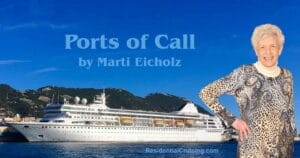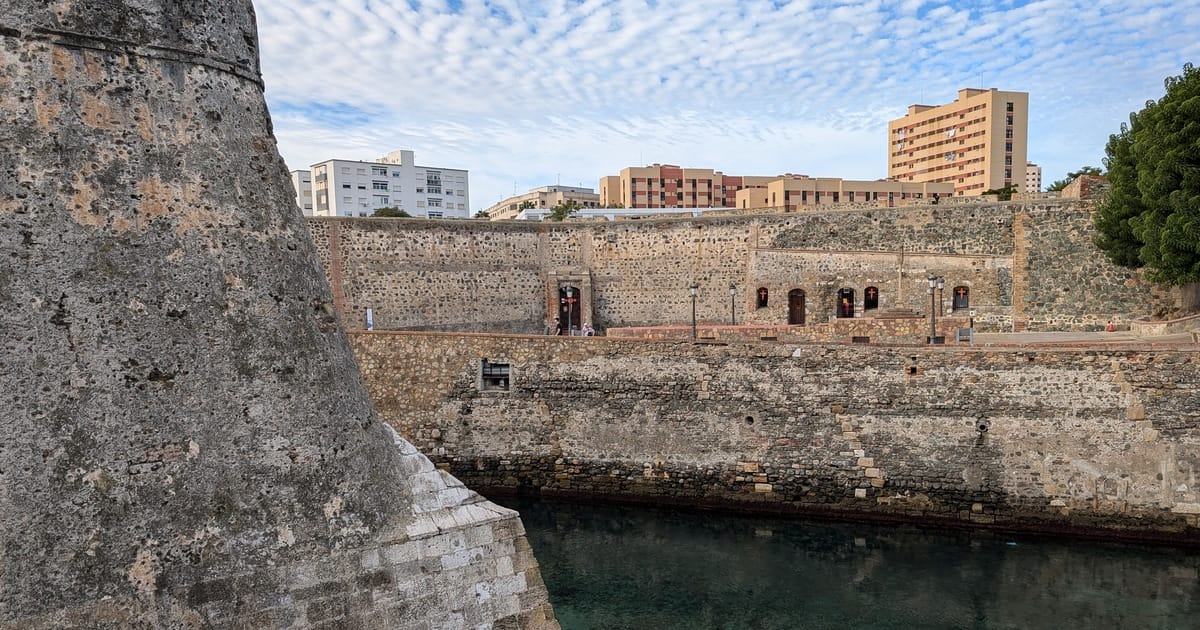Editor’s Note: Columnist Marti Eicholz reports on the ports we visit. Click her byline for a list of her columns. I still think every 10 days or so will be the right pace for these, but we’re already far enough behind that I’ll pick up the pace here and there when needed. -rc
Tangier, Morocco
October 18
Tangier, a City on the Sea, straddling the Mediterranean Sea and the Atlantic Ocean, an old city (2,500 years) and a home to the Phoenicians, Carthaginians, Romans, Byzatine, British, and Spanish.
 Tangier is one of North Africa’s most ancient cities, making it a great introduction to Africa. Today, with a million population, a beautiful mix of cultures and nationalities, it truly is a Multi-Cultural City.
Tangier is one of North Africa’s most ancient cities, making it a great introduction to Africa. Today, with a million population, a beautiful mix of cultures and nationalities, it truly is a Multi-Cultural City.
Tangier is built on the slopes of a chalky limestone hill and appears to rise like an amphitheater into the low hills. Domes and minarets rise high above the white, flat-topped houses.
In the mid 20th century, Tangier was a famous destination for the European and American literary set.
We have two days here so, what do we do? To give you a bird’s eye view in a short period of time, Take the Hop-On, Hop-Off Bus and many did.
Tangier is a walkable, so plan your stroll around the main attraction, The Tangier Medina, old town, the largest of its kind on the planet and the most picturesque and iconic of the city’s various quarters.
You’ll find narrow streets, winding alleys, colorful staircases, vibrant bougainvilla hanging from the walls, fascinating artisan workshops, and historic neighborhoods (small museums in restored mansions and monuments) and souks (Arab marketplace with charming stalls, small shops).
If you like shopping then these souks are the place for you. They are laden with leather goods, clothing, fruits, vegetables, handmade cooper and brass jewelry, ceramics and spices.
Spices are the most popular thing to buy, not only for cooking but a spice to help you sleep, or one for your diet, or to improve your sinsuses or one to help you stop snoring.
As you can tell, Moroccan old town is a micro-world where life flows down every street and the soccos tempt you.
When you are ready to leave this small universe bursting with life, navigate the steep streets to the oldest part, dating from the 10th century, situated on the upper part of the market, is the Kasbah.
The Kasbah is a fortress, consisting of towers and a walled complex (inside were houses). The Kasbah protected against enemy attacks, provided refuge to people and domestic animals.
The Museum of Moroccan Art is close by and has a magnificent archaeology exhibit. The north side of the Kasbah grants a brief glimpse of the Bay of Tangier through gorge-like alleys.
For lunch our ship’s chef prepared a full of goodness Lamb Tagine with a heady blend of flavors (richly spiced), studded with almonds, walnuts, raisins, turmeric, garlic, ginger, cinnamon and cumin served with couscous.
Couscous is the most famous food, often steamed with vegetables and sometimes stewed meat is added. Another treat is Amelou, a thick and nutty dip made from almonds and honey. Morocco is one of the few countries where the almond tree grows naturally. You are not likely to find this specialty in any other place in the world, making it unique and fascinating.
Other dishes common here are hummus, Chicken with Almonds, Meat Skewers, and Zaalouk (eggplant and tomato seasoned with paprika, cumin, garlic and herbs often served as a dip with crusty bread or pita).
A few spent time at the beach, exploring the coastline, and some pretended to be like Lawrence of Arabia, riding a camel and yes, they are smelly and a bit erratic.
Some not to miss spots were:
A day trip to Cap Spartal, a declared Natural Reserve, where looms a stylish lighthouse, resembling a Mosque. Its light guides sailors today.
Caves of Hercules, a cave system, located in a cliff. The lighting plays with the rocks such as: one crack reveals the Atlantic Ocean in the shape of Africa. Interesting…
A favorite for many was the day trip to Chefchaoen (The Blue City), a captivating escape, high in the Rix mountains, into a world of vibrant blue hues, traditional charm and scenic wonders.
Leaving the bustling Tangier, one wonders could you get used to its pace; at times it seemed frenetic.
Some say Tangier is too commercialized, not a true Moroccan experience. Some feel they get a hard sell on every street corner. Those who know Morocco well say Fez and Marrakech are more spectacular and provide a truer Moroccan experience.
As we set sail for our next port, Port of Ceuta, Spain, we dine on Moroccan taste treats.
Ceuta, Spain
October 19
A tiny seaport located in the Strait of Gibraltar, the Port of Ceuta is often called, “a little piece of Spain in Morocco.” Sixty percent of the people are Spanish/Roman Catholic and 39% are Moroccan/Muslim. It is an open city, meaning different cultures such as Christian, Muslim, Hindu and Jewish come together and intermingle.
Ceuta is surrounded by imposing and beautiful Royal Ramparts, built for defense purposes.
What’s Ceuta like? Neat and tidy. Safe, calm and peaceful. Speak Spanish…real Spanish. Yellow is the color. European style architecture. Bike or walk.
Plaza de los Reyes, the square named after the statues of the kings and also holds Iglesia de San Francisco, the church with a yellow facade.
Plaza de la Constitucion is where the half naked lady in bronze was placed in 2017. Her name is Calypso, the goddess who according to the Odyssey saved Ulysses’ life after his ship wrecked on the island of Ogygia near the Pillars of Hercules. Calypso fell in love with Ulysses.
The city was delighted and full of enthusiasm with the statue, considering it a symbol, reinforcing their historical and cultural identity. Nearby there are six allegoric statues, representing: Peace, Africa, Industry, Arts, Trade, Work. Another famous statue is of Hercules separating his pillars.
From our ship, the beach is only a 500 yard walk.
We set sail at 10 for Gibraltar, U.K.

Gibraltar
October 21
Gibraltar is nestled at the southernmost tip of Spain, dominated by “The Rock”, a 426 meter high Jurassic Limestone. Referred to by locals as “Gib”. Limited space (3 square miles) for under 40,000 inhabitants living in high rise accommodations. Self governing with their own Parliament, yet passionate about being British.
Enjoy their Britishness. Eat fish and chips but, drive on the right. Use the same time zone as Spain.
Wandered through the Botanic Gardens, The Alameda, a small park with a big message for raising awareness of endangered species. Viewed the collection of both exotic and native species. Admired what’s flowering and their simplicity: Jersey Lily, Angel’s Trumpet, Bird of Paradise, and Tawain Cotton Rose. Butterflies abound. This is horticulture at its finest.
Take a short cable car ride to the Top Station. Epic views in all directions. To the South, the Strait of Gibraltar and the continent of Africa. To the East is Costa del Sol. To the North Southern Spain.
The Rock’s most famous residents, 230 Barbary Macaques, tailless apes, little charmers that will distract you and then snatch any loose possession in a jiffy. Heed the warning signs! Do not feed or mock them…they will retaliate and bite. One could be fined up to 4,000 pounds (around US$5,2000).
Walk down to St. Michael’s Cave, a stunning natural grotto with breathtaking stalagmites and stalactites, resembling pipes of a cathedral organ. Some believe this was the home to the earliest inhabitants, and also believed it linked Gibraltar to Africa. It served as a hospital during World War II.
A great setting for writing a piece of historical fiction. Walk down the road to the Great Siege Tunnel. Continue down to the remains of the Moorish Castle built in the 11th century. The Tower is the only part of the original that remains today.
Legs are burning.
Ground level, you’re amongst residential hillside homes and streets. Main Street, a shopping street with a mix of pubs, electronics, department stores, and a haven for tax-free shopping.
Parallel to Main Street is Irish Town, a good place to grab a full English breakfast or fish and chips. Calentita, the national dish, is like a Yorkshire pudding pancake but made from chickpeas. Plenty of Tea.
As we leave Gibraltar, think of it as “a little slice of Britain in the sunshine.”
(Note! This video is 34 minutes.)
Last Updated November 6, 2024 Originally Published November 6, 2024- About the Author
- Latest Posts


Great stuff!
Being British I wonder what a Yorkshire pudding pancake is? I’ve made Yorkshire puddings of various sizes but have never heard of a yourkshire pudding pancake.
—
Without consulting Marti, I’d guess it’s just how they described it to her. After all, the pudding is simply a batter of eggs, flour, and milk/water …just like pancakes are. -rc
I absolutely love the way you describe your travels! Thank you for sharing your journey!